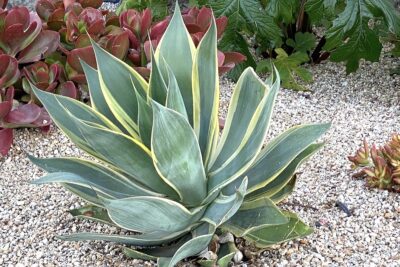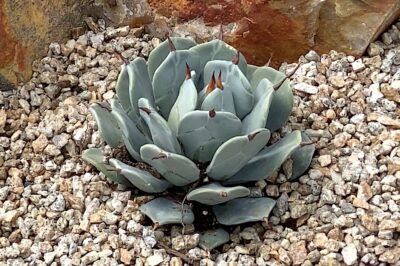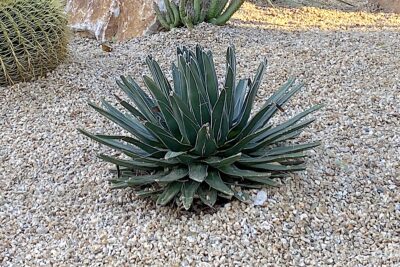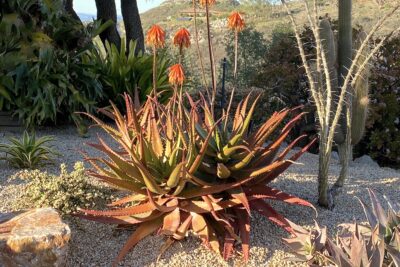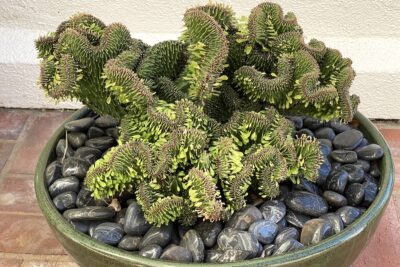
See a Succulent Collectors’ Garden Renovation
In my latest video, I take you to a newly renovated collector's garden north of San Diego. You'll enjoy a living gallery of rare and unusual succulents with an emphasis on variegates (those with stripes). I’ve followed this garden since 2008, and it's in my books. Over time it became overgrown and needed a good going-over. Included are before-and-after photos, plant IDs, and insights and tips from the designer.

Succulent vignette with rocks
The layout was fine, but a lot of plant material needed to be removed to reveal (or to salvage) large, mature specimens that deserved prominence.
The owners, who are discerning succulent collectors, hired landscape contractor Steve McDearmon of Garden Rhythms, who specializes in cactus and succulents. At the owners' request, Steve brought in additional stunning specimens to add to their collection. In the video, Steve shows us the garden as it nears completion.

Planted area under sumac
Sources
The majority of new plant material came from:
In addition there are succulents being trialed (tested) in the garden that are not yet commercially available.
Steve also brought in more than 24 yards of soil, plus warm-hued rocks, boulders and gravel.
Steve's rocks

Left: rubble rock; center, 3/8-inch gravel; right ornamental boulder.
Steve's tried-and-true combo of three kinds of rock includes boulders that blend hues of blue-gray, lavender and rust. At KRC Rock they're called Honey Quartz; and at other suppliers---such as Southwest Boulder & Stone---Apache Sunset.
Rocks larger than gravel but slightly smaller than fist-sized are Copper Canyon rubble. Gravel topdressing is 3/8-inch Mojave Gold, which Steve likes because it's "not too bright. It's gray and brown with flecks of white."

Front garden: Before

Front garden: After
15 Steps to a Succulent Garden Renovation
Think of it like clearing out a closet: Take out everything you don't want, keep only what you do, and decide what if anything should be added.
- Assess areas to be redone. Remove any plants that are tired, ailing, ugly, poorly situated, or you no longer like.
- Remove weeds and debris. Trim, prune and cut back anything overgrown.
- Flag large plants that deserve to be focal points.
- Decide which plants should stay, and which will be moved and where.
- As well as design and aesthetics, consider plants' sun-shade requirements and size at maturity.
- Evaluate locations, prior to planting, from main vantage points.
- Check and improve hardscape, walkways, steps, sitting areas, and other people-oriented aspects of the garden.
- Fix any infrastructure issues, such as plumbing, irrigation, lighting, drainage, or terracing. Note: The irrigation Steve mentions is Netafim techline. (Affiliate link)
- When you have a (relatively) blank slate, bring in soil and create mounds and swales.
- Add boulders so they look natural---not evenly spaced or in straight lines, but rather solo and in groupings.
- Set plants where they'll go. Place those you're repositioning or are in nursery pots atop the soil and adjust as needed.
- Once everything's planted, double-check irrigation.
- Add topdressing. Start with swaths of rubble rock that border pathways.
- Cover remaining bare soil with two inches of gravel.
- Apply pre-emergent herbicide, a powder that stops weeds from germinating.
Gallery of Collectors' Garden plants
Related Info on this Site
Why You Really Need Rocks
Smart designers cover bare soil with rocks in succulent gardens that are as sophisticated and good-looking as they are practical.
Carolyn’s Dragon Tree Garden, Before-and-After
See a colorful, professionally done garden of low-water, regionally appropriate succulents, some unusual, many large, and all thriving today, seven years after installation. Includes designer tips, specs and gallery of 40+ plants.
Succulent Landscapes
Succulent Landscapes Design ideas and must-dos for your yard’s transformation Want to transform your yard into a low-maintenance, low-water succulent garden? This page guides you to helpful info on this site and on my YouTube channel. Before you purchase plants or pick up a shovel, do obtain my book Designing with Succulents (2nd ed). It’s mainly about…


